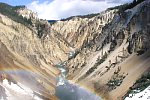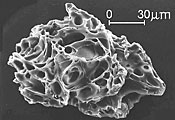|
What's New on USGS Volcano Web Sites?
|
Summary of April 2004 Earthquake Swarm at Yellowstone |
 In
April 2004 there was an increase in earthquake activity, called a
swarm, at Yellowstone National Park that drew interest from scientists
and the public. Swarms can occur on volcanoes or in tectonically active
areas and there have been many swarms recorded over the past 40 years
at Yellowstone. For more information see Earthquake
Swarms at Yellowstone. In
April 2004 there was an increase in earthquake activity, called a
swarm, at Yellowstone National Park that drew interest from scientists
and the public. Swarms can occur on volcanoes or in tectonically active
areas and there have been many swarms recorded over the past 40 years
at Yellowstone. For more information see Earthquake
Swarms at Yellowstone.
|
Volcanic Ash—What it can do and how to prevent damage |
 Volcanic
ash typically covers a much larger area and disrupts the lives of
far more people than the other more lethal types of volcano hazards,
but information about ash and what to do with it is not readily available.
By creating an online resource about the known effects of volcanic
ash and summarizing how people have dealt with the tiny abrasive rock
particles during and after recent eruptions, the USGS and partners
hope people can learn to prepare and protect themselves from future
volcanic ash fall. Go to the volcano ash Web material. Volcanic
ash typically covers a much larger area and disrupts the lives of
far more people than the other more lethal types of volcano hazards,
but information about ash and what to do with it is not readily available.
By creating an online resource about the known effects of volcanic
ash and summarizing how people have dealt with the tiny abrasive rock
particles during and after recent eruptions, the USGS and partners
hope people can learn to prepare and protect themselves from future
volcanic ash fall. Go to the volcano ash Web material.
|
Predict an Eruption: Case Study from Kilauea and Mount St. Helens
volcanoes |
 Try your
hand at predicting an eruption of Mount St. Helens volcano using data
collected by scientists of the USGS Cascades Volcano Observatory.
This presentation uses data from several eruptive episodes of Mount
St. Helens in the 1980's to show the way in which a series of eruptions
were accurately predicted by USGS scientists as far as 3 weeks in
advance. Go to Predict
an Eruption. Try your
hand at predicting an eruption of Mount St. Helens volcano using data
collected by scientists of the USGS Cascades Volcano Observatory.
This presentation uses data from several eruptive episodes of Mount
St. Helens in the 1980's to show the way in which a series of eruptions
were accurately predicted by USGS scientists as far as 3 weeks in
advance. Go to Predict
an Eruption. |
 Current issue of Volcano
Watch, a weekly essay written by USGS scientists from the
Hawaiian Volcano Observatory.
Current issue of Volcano
Watch, a weekly essay written by USGS scientists from the
Hawaiian Volcano Observatory.
|
